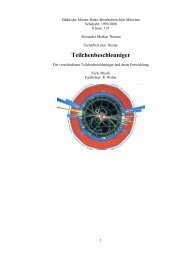The FEE Server Control Engine of the ALICE-TRD - Westfälische ...
The FEE Server Control Engine of the ALICE-TRD - Westfälische ...
The FEE Server Control Engine of the ALICE-TRD - Westfälische ...
Create successful ePaper yourself
Turn your PDF publications into a flip-book with our unique Google optimized e-Paper software.
6 Temperature Monitoring <strong>of</strong> <strong>the</strong> Front End<br />
Readout Electronics<br />
6.1 Temperature Monitoring Inside <strong>the</strong> Supermodule<br />
Monitoring <strong>the</strong> temperature inside <strong>the</strong> supermodule is important for different reasons.<br />
First <strong>of</strong> all measuring <strong>the</strong> temperature is <strong>the</strong> only technically feasible solution to check<br />
<strong>the</strong> proper cooling <strong>of</strong> all MCMs. <strong>The</strong> silicon hoses or <strong>the</strong> small aluminum tubes can be<br />
blocked and in consequence <strong>the</strong> corresponding MCM column remains uncooled. Fur<strong>the</strong>rmore<br />
a silicon hose can be laced up due to <strong>the</strong> under-pressure when not properly<br />
routed. Especially in layer five this has happened several times. As long as <strong>the</strong>se problems<br />
are detected during supermodule integration <strong>the</strong>y can be fixed. After a supermodule<br />
is finished, it is very difficult if not even impossible to fix cooling problems in <strong>the</strong><br />
supermodule.<br />
During normal <strong>TRD</strong> operation <strong>the</strong> most probable failure in <strong>the</strong> cooling system is a<br />
breakdown <strong>of</strong> <strong>the</strong> cooling plant. Such a failure should be detected by <strong>the</strong> monitoring<br />
s<strong>of</strong>tware <strong>of</strong> <strong>the</strong> cooling plant and results in a shutdown <strong>of</strong> <strong>the</strong> <strong>TRD</strong>. However, monitoring<br />
<strong>the</strong> temperature in <strong>the</strong> supermodules provides a good extension and a fallback system for<br />
cooling monitoring. Lastly, <strong>the</strong> temperature inside <strong>the</strong> supermodule is also interesting<br />
for physical reasons. <strong>The</strong> drift velocity in <strong>the</strong> Ar-CO2 gas mixture inside <strong>the</strong> chambers<br />
depends on <strong>the</strong> temperature. Even though <strong>the</strong> <strong>the</strong>rmal coupling between <strong>the</strong> gas mixture<br />
in <strong>the</strong> chambers and <strong>the</strong> ambient air is weak and <strong>the</strong> drift velocity in <strong>the</strong> gas mixture is<br />
monitored separately, measuring <strong>the</strong> temperature may give useful information about <strong>the</strong><br />
environment conditions.<br />
Each ROC has three different types <strong>of</strong> temperature sensors. <strong>The</strong> first one is a dedicated<br />
temperature sensor connected to <strong>the</strong> DCS board. It is placed about 2 cm away from <strong>the</strong><br />
DCS board. <strong>The</strong>refore it measures <strong>the</strong> air temperature in <strong>the</strong> surroundings <strong>of</strong> <strong>the</strong> DCS<br />
board. <strong>The</strong> sensor is a 10 MΩ NTC resistor. <strong>The</strong> voltage drop in <strong>the</strong> resistor is digitized<br />
by an ADC on <strong>the</strong> DCS board. <strong>The</strong> <strong>FEE</strong><strong>Server</strong> running on <strong>the</strong> DCS board reads out <strong>the</strong><br />
sensor in regular intervals, converts <strong>the</strong> sensor reading to a temperature measured in<br />
degree Celsius and publishes <strong>the</strong> value via DIM.<br />
<strong>The</strong> DCS board has a second temperature sensor directly mounted on <strong>the</strong> board. However,<br />
this second sensor is not calibrated and measures <strong>the</strong> local DCS board temperature<br />
only. <strong>The</strong>refore this sensor is not used.<br />
Finally, each MCM has an embedded temperature sensor which measures <strong>the</strong> temperature<br />
inside <strong>the</strong> MCM. <strong>The</strong>refore, <strong>the</strong>se sensors give a very localized temperature,<br />
in contrast to <strong>the</strong> temperature sensor connected to <strong>the</strong> DCS board which measures <strong>the</strong><br />
global air temperature. Since <strong>the</strong> MCM has six sensors in total (<strong>the</strong> temperature sensor<br />
and five voltage sensors to measure different voltages in <strong>the</strong> MCM) but only one 10 bit,<br />
80 kSamples/s ADC [A + 05] to digitalize sensor readings, an analog multiplexer is used<br />
75







